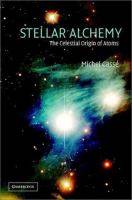Stellar Alchemy The Celestial Origin of Atoms
- Unit price
- / per
-
Author:CASSE Michel / LYLE Stephen
-
ISBN:9780521821827
-
Publication Date:August 2003
-
Edition:1
-
Pages:256
-
Binding:Hardback
-
Publisher:Cambridge University Press
-
Country of Publication:


A Back Order button means that we don’t have the book in stock at our store. It may already be on order – or we can order it for you from a publisher or distributor at no additional cost.
As we source items from around the globe, a back-order can take anywhere from 5 days to several weeks to arrive, depending on the title.
To check how long this might take, you’re welcome to contact us and we can provide an ETA or any other information you need. We recommend checking the timeframe before committing to an online order.
Stellar Alchemy The Celestial Origin of Atoms
- Unit price
- / per
-
Author:CASSE Michel / LYLE Stephen
-
ISBN:9780521821827
-
Publication Date:August 2003
-
Edition:1
-
Pages:256
-
Binding:Hardback
-
Publisher:Cambridge University Press
-
Country of Publication:
Description
Contents:
Preface; 1. Nuclear astrophysics: defence and illustration; 2. Light from atoms, light from the sky; 3. Visions; 4. Contents of the sky: atomic sources and fountains; 5. Nuclear suns; 6. Sociology of stars and clouds; 7. Histories; 8. Ancient stars in the galactic halo; 9. Conclusion; Appendices.
Adding product to your cart
You may also like
A Back Order button means that we don’t have the book in stock at our store. It may already be on order – or we can order it for you from a publisher or distributor at no additional cost.
As we source items from around the globe, a back-order can take anywhere from 5 days to several weeks to arrive, depending on the title.
To check how long this might take, you’re welcome to contact us and we can provide an ETA or any other information you need. We recommend checking the timeframe before committing to an online order.
You may also like
You may also like
-
Why do the stars shine? What messages can we read in the light they send to us from the depths of the night? Nuclear astrophysics is a fascinating discipline, and enables connections to be made between atoms, stars, and human beings. Through modern astronomy, scientists have managed to unravel the full history of the chemical elements, and understand how they originated and evolved into all the elements that compose our surroundings today. The transformation of metals into gold, something once dreamed of by alchemists, is a process commonly occurring in the cores of massive stars. But the most exciting revelation is the intimate connection that humanity itself has with the debris of exploded stars. This engaging account of nucleosynthesis in stars, and the associated chemical evolution of the Universe, is suitable for the general reader.
Contents:
Preface; 1. Nuclear astrophysics: defence and illustration; 2. Light from atoms, light from the sky; 3. Visions; 4. Contents of the sky: atomic sources and fountains; 5. Nuclear suns; 6. Sociology of stars and clouds; 7. Histories; 8. Ancient stars in the galactic halo; 9. Conclusion; Appendices. -
-
Author: CASSE Michel / LYLE StephenISBN: 9780521821827Publication Date: August 2003Edition: 1Pages: 256Binding: HardbackPublisher: Cambridge University PressCountry of Publication:
Why do the stars shine? What messages can we read in the light they send to us from the depths of the night? Nuclear astrophysics is a fascinating discipline, and enables connections to be made between atoms, stars, and human beings. Through modern astronomy, scientists have managed to unravel the full history of the chemical elements, and understand how they originated and evolved into all the elements that compose our surroundings today. The transformation of metals into gold, something once dreamed of by alchemists, is a process commonly occurring in the cores of massive stars. But the most exciting revelation is the intimate connection that humanity itself has with the debris of exploded stars. This engaging account of nucleosynthesis in stars, and the associated chemical evolution of the Universe, is suitable for the general reader.
Contents:
Preface; 1. Nuclear astrophysics: defence and illustration; 2. Light from atoms, light from the sky; 3. Visions; 4. Contents of the sky: atomic sources and fountains; 5. Nuclear suns; 6. Sociology of stars and clouds; 7. Histories; 8. Ancient stars in the galactic halo; 9. Conclusion; Appendices.-
Author: CASSE Michel / LYLE StephenISBN: 9780521821827Publication Date: August 2003Edition: 1Pages: 256Binding: HardbackPublisher: Cambridge University PressCountry of Publication:
-



